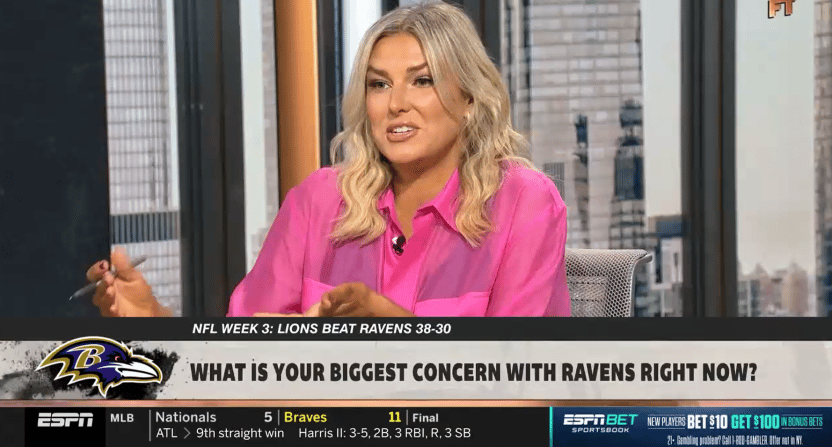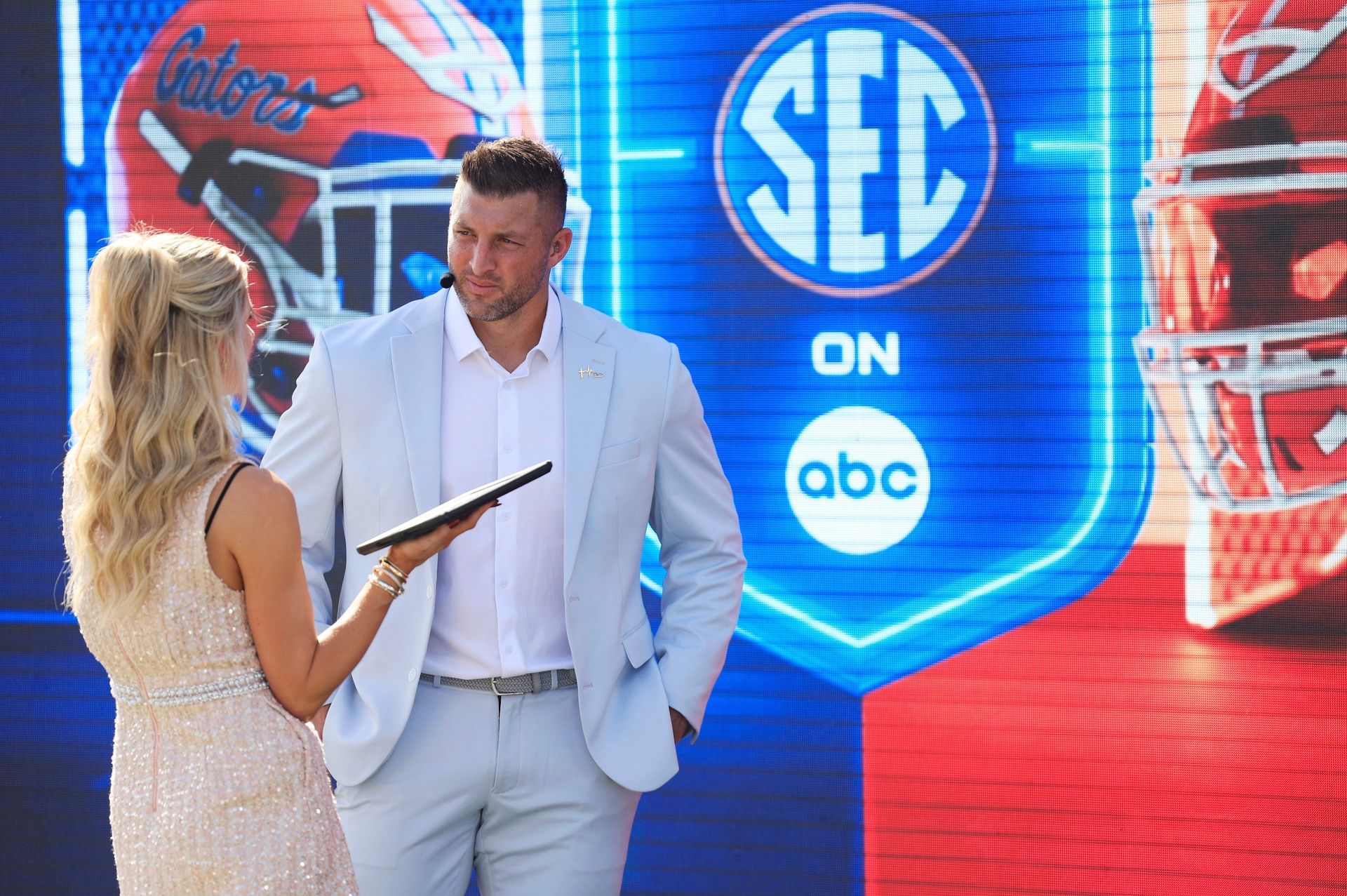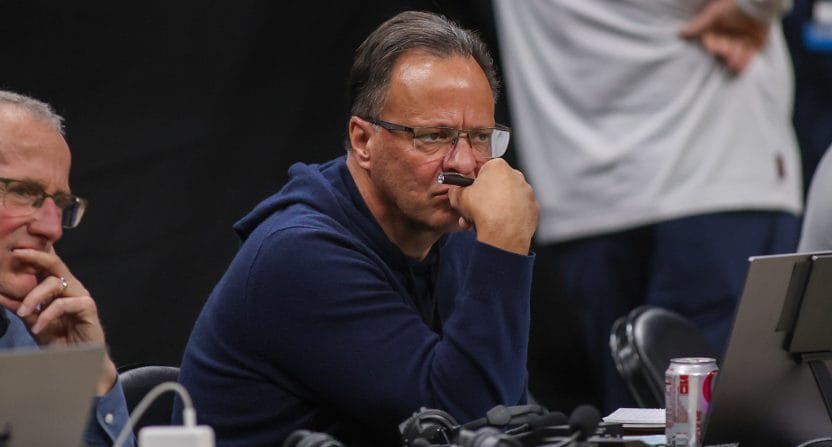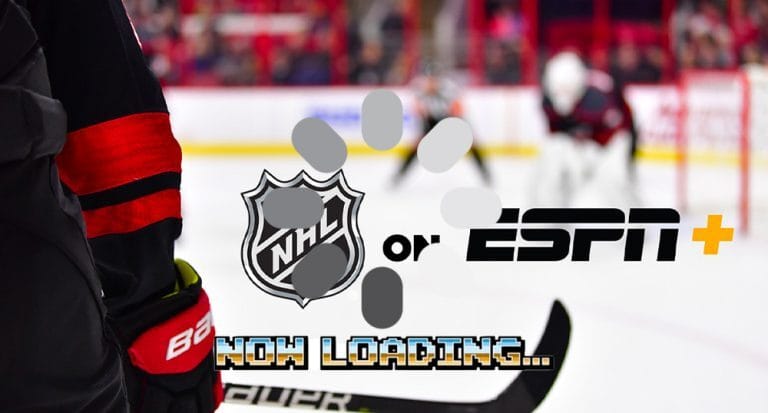- Awful Announcing's The A Block
- Posts
- The SEC on ABC is inevitable
The SEC on ABC is inevitable
Other networks simply cannot compete with SEC tripleheaders every Saturday
Welcome to The A Block, Awful Announcing’s daily newsletter where you’ll always find the latest sports media news, commentary, and analysis.
Did someone share this newsletter with you? Sign up for free to make sure you never miss it.
🎤 QUICK START ✍️

Credit: ESPN
🌟 Club Shae Shae. ESPN has officially landed on a new First Take host: Shae Cornette. The network announced yesterday that the current SportsCenter anchor will take the reins on its preeminent debate show beginning November 3. Cornette joined ESPN in 2020 following stints at ESPN 1000, Fox 32, and ABC 7 in Chicago, as well as the Big Ten Network.
🦪 Pearly lights. Former Auburn men’s basketball coach Bruce Pearl will trade the sidelines for the bright lights of television this year, joining both CBS Sports and TNT Sports as a college basketball analyst. The 4-time SEC Coach of the Year will call games and work studio for CBS, with TNT deploying him alongside Adam Lefkoe, Jalen Rose, and Jamal Mashburn in its studio.
📺 Good Morning, Stephen. ESPN’s $100 million man, Stephen A. Smith, will co-host ABC’s Good Morning America today before his usual commitments on (checks notes) First Take, his daily SiriusXM show, and whatever cable news program he’ll inevitably decide to appear on.
️🚨 LEADING OFF 🚨
ABC’s college football dominance is inevitable

Credit: Corey Perrine/Florida Times-Union
We’ve officially reached the midway point of the college football season (time flies, right?), which provides a good opportunity to review how the sport’s ratings battle is shaping up. And for a second consecutive year, “battle” might be too generous of a word. So far, this isn’t a competition.
In Year 2 of its SEC monopoly, ABC/ESPN is dominating college football viewership once again.
Yesterday’s newsletter featured a great piece from Awful Announcing owner Ben Koo, which took last weekend’s lackluster ratings for Indiana-Oregon on CBS, a game that featured two College Football Playoff contenders and two Heisman candidates, and explained how it could finish in a distant fourth place on last Saturday’s slate.
Today, we’ll take a more macro-level view of how this season has gone and why ABC is destined to hold its position at the top of the podium into the 2030s.
Let’s begin with a few stats, all of which serve to support the same general point. Through seven weeks of the college football season, ABC has won 17 of the 21 Saturday broadcast network windows. In other words, comparing noon games to noon games, afternoon to afternoon, and primetime to primetime, ABC has come out on top all but four times. Fox’s Big Noon Saturday has won its timeslot in four out of seven weeks, with every other window going to ABC, including a clean sweep of afternoon and primetime.
Further, ABC is dominating from a pure volume perspective as well. When looking at games that have averaged over 5 million viewers this season, ABC has aired 15 of them. CBS has aired three such games, while Fox and NBC have aired two apiece. In other words, not only is ABC beating its competition head-to-head, but it’s airing more than double the amount of high-leverage games than the other three broadcast networks combined.
To drive this point home even further, ESPN’s research guru Flora Kelly revealed yesterday that the ESPN family of networks has accounted for 61% of ALL college football viewing so far this season, leaving everyone else fighting for scraps.
We are midseason and college football is up 20% vs last year. The sport has a record high 90 Billion watched of live games.
ESPN-nets/ABC accounted for 61% of ALL college football viewing - up from 57% last year.
— Flora Kelly (@ESPNFlora)
8:29 PM • Oct 16, 2025
That’s a scary proposition for Fox, CBS, and NBC.
To put things in perspective, those three networks are paying a combined $1.15 billion annually to air the Big Ten. ABC/ESPN is paying just $710 million per year for the entirety of the SEC. And so far, ABC is wiping the floor with its package.
There are a few factors at play here. For one, ABC has the distinct advantage of airing a tripleheader each week. Each game is able to draw from the audience’s tuning in for the one before or after. The Big Ten partners do not have that. Instead, they’re deploying an NFL model that creates friction. Fox at noon. CBS and 3:30. NBC in primetime. Each time a viewer flips channels between games, they have a chance to land on ABC, whereas someone tuned into the noon SEC game may well stay on ABC the entire day without flipping around.
Two, the SEC’s regionality plays an important role. As the lone conference that still has some semblance of regional sensibility, fans of say, Ole Miss, are likely more interested in watching an SEC game not involving their school, like Tennessee-Auburn, than an Iowa fan would be interested in watching a game like Washington-Maryland. The shared history and rivalries keep SEC fans tuned into the conference’s games no matter what, while fans of Big Ten schools are more apt to simply watch whatever the best game is at any given time.
Three, as Ben explained at length in his piece, the Big Ten has a brand problem. Indiana and Oregon do not move the needle like Alabama, Texas, LSU, Georgia, etc. No one is “hate-watching” the Hoosiers or the Ducks. But if a top-flight SEC team is on the ropes? You bet everyone is tuning in.
Don’t expect much to change until there’s a new round of media rights agreements or (shivers) conference realignment. Disney’s deal with the SEC goes through 2034. The Big Ten’s trio of deals terminates in 2030. The status quo is here, and it’d take an act of God before any meaningful movement.
CBS and NBC are the worst off, fighting for scraps of Big Ten inventory that is largely dominated by Fox, and lacking the habitual viewership that comes with a weekly marquee window. Fox, while likely playing second fiddle to ABC for the next five years from a ratings perspective, is largely satisfied. After all, they’re essentially being paid by both CBS and NBC for what amounts to Tier 2 inventory as a result of Fox’s majority ownership stake in Big Ten Network. (The channel, not the conference, controls media rights for the league.)
One potential shakeup to the status quo could come from Paramount’s potential acquisition of Warner Bros. Discovery. That deal is still a long way off, but if it happens, CBS Sports would take control of the college football rights currently owned by TNT Sports, which includes College Football Playoff inventory sublicensed from ESPN, and a package of Big 12 games. Even still, such a deal would barely move the needle until late December, when playoff games begin.
All of this is a long way of saying, the sport of college football runs through ABC and ESPN, and it will for the foreseeable future. Not only is the network dominating viewership, but they’re doing it for far cheaper than its primary competition: the Big Ten’s media partners. Further, ABC/ESPN’s deal goes for four years longer than their Big Ten counterparts. And to be frank, there’s not much the competition can do to catch up.
📺 INDUSTRY INSIGHTS 🎬

Credit: Brett Davis-Imagn Images
Tom Crean will join the Minnesota Timberwolves studio team on FanDuel Sports Network North, splitting time with Minnesota Lynx assistant coach Rebekkah Brunson as pregame and postgame analyst.
Longtime Meadowlark Media producer Billy Gil is leaving the company to take an “off-air management position” at The Ringer. Gil has regularly contributed on-air for The Dan Le Batard Show with Stugotz.
Recently fired Penn State head coach James Franklin will appear on Saturday’s episode of College GameDay for a live interview, his first since his canning last weekend.
FanDuel Sports Network is entering a content partnership with Peyton Manning’s Omaha Productions. Specific programming plans have not yet been announced, but the deal was spearheaded by former ESPN execs Norby Williamson (now with FanDuel Sports Network) and Jamie Horowitz (now at Omaha).
The ATP and WTA Tours are very close to agreeing to merge their commercial operations, Stacey Allaster, CEO of professional tennis at the USTA, this morning told a sports business conference hosted by Columbia University’s School of Professional Studies.
Digital publisher The Arena Group is acquiring the digital assets of Lindy’s Sports. The sports brand, best known for its annual football preview magazines, joins a collection of properties that includes Men’s Journal, Athlon Sports, Men’s Fitness, and The Spun, all of which currently exist under The Arena Group banner.
📣 THE PLAY-BY-PLAY 🎙️
🔥 THE CLOSER 🔥
Streaming struggles

Edit by Liam McGuire
On Wednesday, hockey podcasters DJ Bean and Pete Blackburn exposed what seems to be a widespread issue among ESPN app users. Fans watching live games on Smart TVs were often unknowingly falling behind live action, seemingly due to ESPN’s commercial breaks running longer than the commercial breaks on the linear broadcast.
Here’s the clip if you missed it:
What Chaos! Finds Out:
Are ESPN+ games no longer live???
— What Chaos! (@WhatChaosShow)
9:27 PM • Oct 15, 2025
Now, the suggestion that ESPN would be doing this in order to fit additional ads into its streams was entirely presumptuous. After all, there are countless times when live events on the ESPN app don’t air commercials at all, instead showing a simple “Your event is in a commercial break” slate before returning to live action. The revenue ESPN would get by squeezing a few more ads into programming that isn’t very widely watched to begin with is so marginal that it wouldn’t make any sense to try to pull a fast one on consumers like this. Especially in a way where folks could pretty easily find out this was happening.
But even if ESPN didn’t have nefarious intentions, the fact that this is happening is still a big deal. The network recently launched its highly anticipated direct-to-consumer app, which runs users $30 per month for the Unlimited package, and $12 per month for Select (formerly ESPN+). At those prices, viewers should, at a minimum, be able to watch live games in real-time.
So what is happening? Well, Awful Announcing reached out to ESPN for an explanation.
In short, the network claims its new app is designed to give fans the best viewing experience possible. As such, its video player combats buffering and latency issues by returning users to the point of interruption, rather than jumping ahead and having viewers miss action. This behavior also applies to ad breaks. So if your stream takes a few seconds to load an ad during a commercial break, you’ll rejoin the broadcast a few seconds late. These instances can accumulate over time, causing viewers to be a few minutes behind live action towards the end of a game.
ESPN says it is actively looking to address the issue.
Not to be dramatic, but this has to be fixed. Fans cannot unknowingly fall minutes behind live action when they’re paying as much as $30 for a service. Especially with ESPN pushing gambling integration into its new app, the optics of having a stream that falls behind by design are not great. Not to mention, fans can easily get a game spoiled simply by checking social media or receiving a text.
It’s not the type of user experience one should expect from a premium-priced streaming service. Hopefully, it’s not something fans will have to deal with for much longer.
Thank you for reading The A Block! Sign up for free to make sure you never miss it.